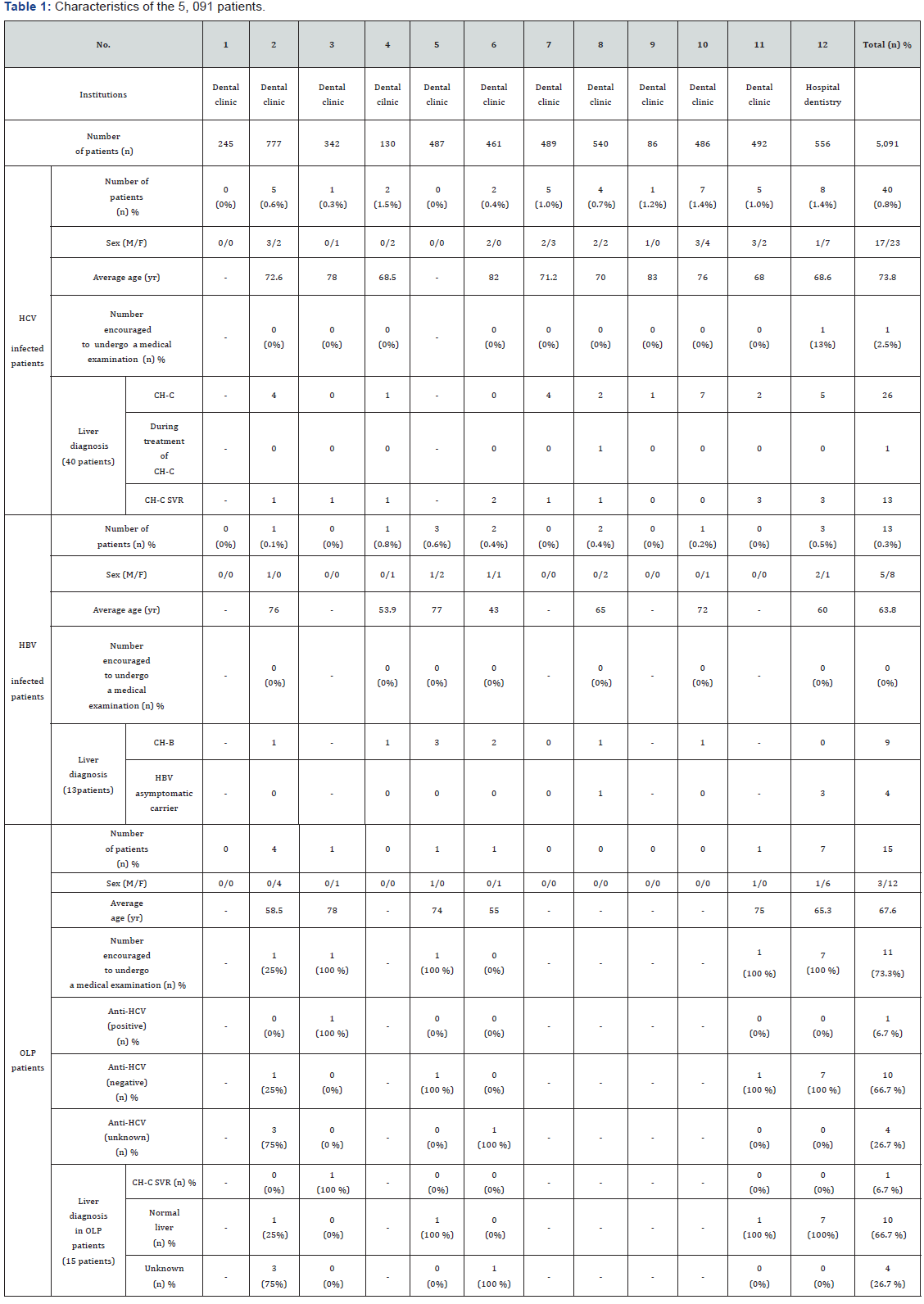Promotion by Dentists of Treatment of Undiagnosed and Untreated HCV-Infected Patients_Juniper Publishers
ADVANCED RESEARCH IN GASTROENTEROLOGY & HEPATOLOGY JUNIPER PUBLISHERS
Authored by Yumiko Nagao
Abstract
Background: Hepatitis C virus (HCV) infection is common in Japan but may remain untreated. Oral lichen planus (OLP) is an extrahepatic manifestation of HCV infection. The aim of this study was to evaluate prospectively the frequency of referral, by dentists, of their patients to medical doctors for evaluation of untreated viral liver disease and OLP
Materials and methods:Patients who visited 12 dental clinics in Japan from November 1, 2017 to January 31, 2018, were enrolled. The number of patients who visited a dentist, the number of HCV-infected patients, the number of HBV-infected patients, the number of OLP patients, the rate of HCV infection in OLP patients, the number referred to a family doctor for consultation regarding liver disease and the number of OLP patients referred for consultation were recorded.
Results: The total number of patients and the numbers of HCV-infected, HBV-infected, and OLP patients were 5,091, 40, 13, and 15, respectively. One patient was referred for consultation for untreated liver disease and was treated with DAAs. 73% (11/15) of OLP patients were encouraged to submit to examination for liver disease and hepatitis virus infection.
Conclusion: Patients who have complications of liver disease or oral extrahepatic manifestations may visit a dentist. Through cooperation between dentistry and medical care, undiagnosed and untreated hepatitis patients can be provided treatment. It is suggested that general dental clinics can introduce OLP patients relatively easily to medical clinics and hospital dentistry & oral-maxillofacial surgery centers can recommend treatment of untreated HCV-infected individuals.
Keywords: Oral lichen planus (OLP); Hepatitis C virus (HCV); Direct-acting antivirals (DAA); Dentist
Abbrevations: OLP: Oral Lichen Planus; HCV: Hepatitis C Virus; HBV: Hepatitis B Virus; CH-C: Chronic Hepatitis C; HCC: Hepatocellular Carcinoma; DAA: Direct-Acting Antivirals; SVR: Sustained Virological Response
Introduction
An estimated 1.5 to 2 million people are infected with hepatitis C virus (HCV) in Japan and about 30,000 deaths occur from hepatocellular carcinoma (HCC) each year [1,2]. Treatment of chronic viral hepatitis C has advanced dramatically in the past decade with the introduction of direct-acting antivirals (DAAs) [3-5]. However, 800 thousand to one million of these HCVinfected individuals do not know they are infected or remain untreated [6]. HCV infection also is known to cause extrahepatic manifestations in the oral cavity, such as oral lichen planus (OLP) [7,8]. OLP is a chronic inflammatory, mucocutaneous disease, mostly affecting middle-aged females [9]. The rates of HCV infection in patients with OLP are high in Japan, ranging from 62% to 67.8% [10,11]. OLP in HCV-infected individuals was reported to be improved by treatment with DAAs [12-14]. We reported previously a retrospective study showing it is possible to encourage the treatment of patients with viral hepatitis through dentistry [15]. In this study, we examined prospectively the frequency of encouragement of consultation for HCV and hepatitis B virus (HBV)-infection, by dentists, among patients who visited dental clinics.
Materials and Methods
The twelve medical institutions participating in the study were eleven dental clinics which belong to the Shimonoseki- City Dental Association in Yamaguchi prefecture and an oral and maxillofacial surgery center, Western Shimane Medical Center of Health and Welfare in Shimane prefecture. These medical institutions are located in the west of Japan (Figure 1). Parameters examined during the three months from November 1, 2017 to January 31, 2018 are: the number of patients who visited the dental offices, the number of HCV-infected patients, the number of HBV-infected patients, the number of OLP patients, the rate of HCV infection in OLP patients, the number recommended to consultation a family doctor regarding liver disease, and the number of OLP patients recommended to obtain advice regarding liver disease. The dentists interviewed each patient to determine their clinical history and systemic diseases, including liver disease, and offered testing for HCV and HBV infection and referral to a primary physician. They obtained this information in cooperation with a medical institution. Anti-HCV and serum HCV RNA was measured using a chemiluminescent enzyme immunoassay (CLEIA) kit and a quantitative polymerase chain reaction (PCR) assay, respectively. Hepatitis B surface antigen (HBsAg) was measured using a chemiluminescent immunoassay (CLIA) kit.

Ethical considerations
The study was approved by the Ethics Committee of Saga University (reference number: 29-15 and 29-56) in accordance with the Declaration of Helsinki. The study received ethical approval for the use of an opt-out methodology, based on unbiased information.
Results
In the 12 medical institutions, the total number of patients, the number of HCV-infected patients, the number of HBVinfected patients, and the number of OLP patients were 5,091, 40, 13 and 15, respectively (Table 1). The 40 HCV-infected patients were 17 men and 23 women with an average age of 73.8 years. The 13 HBV-infected patients were 5 men and 8 women with an average age of 63.8 years. The 15 OLP patients were 3 men and 12 women with an average age of 67.6 years. The diagnoses of the 53 infected patients were: chronic hepatitis C (CH-C) (26 patients), during treatment of CH-C (1 patient), CH-C with sustained virological response (SVR) (13 patients), chronic hepatitis B (9 patients), and HBV asymptomatic carrier (4 patients). Consultation for untreated CH-C was recommended for one patient, a 72-year-old female, who was then treated with DAAs. Eleven of the 15 (73%) patients with OLP were advised to seek examinations for liver disease and testing for HBV and HCV infection. The diagnoses of these 11 patients were: CH-C with SVR (1 patient) and normal liver (10 patients). The prevalence of HCV infection in the OLP patients was 6.7% [1-15].

HCV: Hepatitis C Virus; HBV: Hepatitis B Virus; SVR: Sustained Virological Response; OLP: Oral Lichen Planus; CH-C: Chronic Hepatitis C; CH-B: Chronic Hepatitis B; M: Male; F: Female
Discussion
Yamaguchi prefecture and Shimane prefecture are always highly ranked in our country in terms of deaths due to liver cancer. The domestic ranking of mortality rate was 3rd in Yamaguchi prefecture in 2015 and 3rd in Shimane prefecture in 2016. Patients who have complications of liver disease or extrahepatic manifestations may visit a dentist. Through cooperation between dentistry and medical care, patients with undiagnosed or untreated hepatitis can be provided treatment.
In this study, there was no case of recommendation from the general dental clinic to a family medical doctor for untreated chronic hepatitis C. The most common reason was “Because patients with CH-C already attend their family doctor”. A general dentist may have difficulty grasping accurately the ramifications of liver disease and providing appropriate advice to patients with HCV or HBV liver disease. One oral surgeon working in a hospital setting referred an untreated HCV-infected patient to a liver specialist. Eventually, this patient was treated with DAAs, involving a 12-week course of ledipasvir (LDV) 90mg and sofosbuvir (SOF) 400mg (Harvoni®; Gilead Sciences Inc., Foster City, CA, USA).
Meanwhile, the proportion OLP patients recommended for screening for liver disease was high (73%). It is suggested that general dentists can refer patients with OLP relatively easily to a family doctor. In our retrospective survey, we reported that the rate of referal and examining HCV infection was 57% and the rate of HCV infection was 29% at an observation period of 1 year and 10 months [15]. We recommended treatment to 80% of HCV-infected patients. As a result, 60% of untreated patients commenced or completed antiviral therapy and all achieved SVR. In the present study, the low referral rate from dentists to family physicians for liver disease patients may be related to the short duration of the study (3 months). Therefore, if this study is continued for a long time, it may be possible to raise the rate of identifying untreated hepatitis patients via a general dentist. In the future, it is desirable to push promote this survey in multiple dental clinics.
Conclusion
In this study, we examined prospectively the rate of recommendation for consultation by a family doctor or liver specialist regarding liver disease and the relationship between OLP, HCV, and HBV infection in 5,091 patients who consulted general dental clinics and a hospital dentistry. It is suggested that general dental clinics could introduce OLP patients relatively easily to the medical clinics, and hospital dentistry & oral-maxillofacial surgery centers could recommend treatment of untreated, HCV-infected individuals by a liver specialist.
Acknowledgement
We thank the Shimonoseki-City Dental Association for support of this study and Dr. Yutaka Horie (Shimaneken Saiseikai Gotsu General Hospital) for treatment of chronic hepatitis C. This study was supported in part by a Grant-in-Aid for Scientific Research (C) (No.17K12012) from the Ministry of Education, Culture, Sports, Science and Technology of Japan.
Conflict of Interest
YN (the corresponding author) is a member of a donationfunded Department, funded by Okuda Internal Medicine, Circulatory Medicine and Naniwamarukaiji Inc.. The remaining authors disclose no conflicts.
For more articles in Advanced Research in Gastroenterology & Hepatology please click on https://juniperpublishers.com/argh/index.php
For more about Juniper Publishers please click on: https://juniperpublishers.com/video-articles.php




Comments
Post a Comment